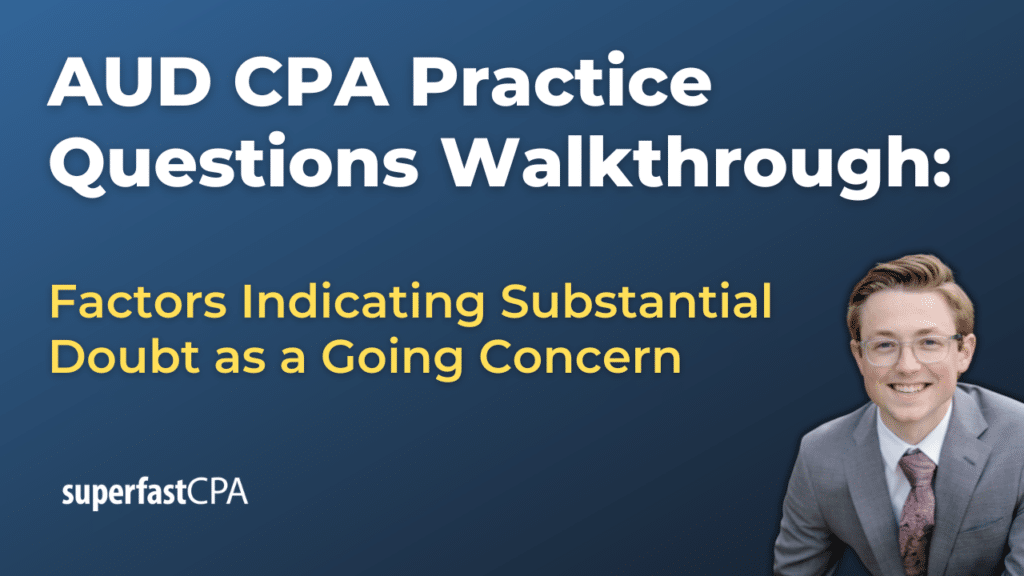In this video, we walk through 5 AUD practice questions teaching about factors indicating substantial doubt as a going concern. These questions are from AUD content area 3 on the AICPA CPA exam blueprints: Performing Further Procedures and Obtaining Evidence
The best way to use this video is to pause each time we get to a new question in the video, and then make your own attempt at the question before watching us go through it.
Also be sure to watch one of our free webinars on the 6 “key ingredients” to an extremely effective & efficient CPA study process here…
Factors Indicating Substantial Doubt as a Going Concern
When auditors perform planned procedures during a financial statement audit, they are expected to assess whether substantial doubt exists about an entity’s ability to continue as a going concern for a reasonable period of time—typically one year beyond the date the financial statements are issued. This assessment is not just a box to check—it’s a critical piece of the audit that can affect the audit report and communications with management and those charged with governance.
Let’s break down the most important things an auditor should understand about this area of the audit.
What Might Raise Substantial Doubt?
Substantial doubt exists when events or conditions indicate the entity may not be able to meet its obligations as they come due. Some examples that might trigger this concern include:
- Recurring negative cash flows from operations
- Severe working capital deficiencies
- Loss of access to customary trade credit (such as vendors suddenly requiring cash on delivery)
If, for instance, an audit client has reported losses for the past three years and is now relying heavily on short-term debt just to meet payroll, those signs could point to a going concern issue.
Can Management Do Anything About It?
Yes. Management can have plans that alleviate the auditor’s concern, but they must be reasonable and supported by evidence. These may include:
- Raising capital through issuing stock or getting new investors
- Borrowing funds from financial institutions
- Restructuring existing debt agreements
- Selling unneeded assets to generate cash
- Cutting or delaying expenditures
If management can show a binding agreement with a lender for new financing or a signed deal to sell a building that would improve liquidity, the auditor may conclude that the doubt has been alleviated.
What Happens If the Doubt Is Alleviated?
If management’s plans are likely to work and disclosures in the financial statements are adequate, the auditor can issue a standard unmodified opinion. They also have the option (but not the requirement) to include an emphasis-of-matter paragraph that highlights the going concern issue—but only if they think it’s important for users to pay attention to.
The key point here is that the auditor may still mention the issue in the report, but it won’t affect the actual audit opinion.
What Happens If the Doubt Remains?
If management’s plans are not convincing and substantial doubt still exists, the auditor is required to include a specific section in the report titled:
“Substantial Doubt About the Entity’s Ability to Continue as a Going Concern.”
This section must explain:
- That substantial doubt exists
- That it may cast significant uncertainty on the entity’s ability to continue
- That the auditor’s opinion is not modified in respect to this matter (as long as disclosure is adequate)
For example, if a small retail chain is losing major suppliers, facing declining sales, and has no clear recovery plan, the auditor would need to flag this in the report, even if the company includes a solid footnote disclosure.
Who Needs to Know About This?
The auditor isn’t done after finalizing the audit report. They must communicate these going concern issues in writing to those charged with governance (e.g., the board of directors or audit committee). This communication should explain:
- What triggered the going concern assessment
- Whether management’s plans alleviate the doubt
- How the matter will be presented in the auditor’s report
This keeps those charged with governance informed of serious financial risk and the auditor’s planned response.
Understanding going concern assessments is about more than just spotting red flags—it’s about knowing how to evaluate management’s response, how to report the issue, and how to communicate it to the right people. These decisions can significantly affect how users of the financial statements view the entity’s financial stability.














